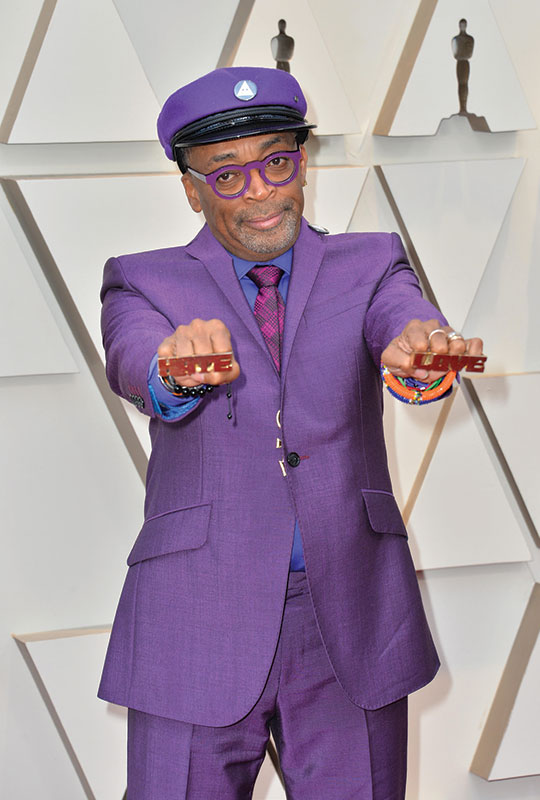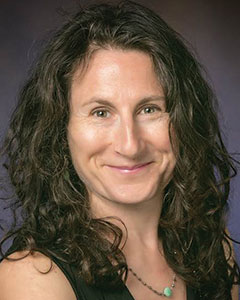Above: Bill Dunn as Radio Raheem in Spike Lee’s Do the Right Thing (Universal, 1989).
Spike Lee arrived at the 2019 Oscars in an awesome royal purple suit (a tribute to his late friend Prince) with matching cool, chunky glasses, sporting giant knuckle rings with HATE and LOVE in large block letters; the rings had been featured in his 1989 film Do the Right Thing. The gesture provoked multiple resonances. For one, the Oscars failed to do the right thing by not nominating his 1989 film for best picture. Moreover, the rings served as a memorial to the actor who so memorably portrayed Radio Raheem, Bill Nunn, who died at sixty-two in 2016 of leukemia, and whose character was murdered by white cops. The rings also struck an evocative chord by reminding us of the rise of hate speech under Trump. In Do the Right Thing, Radio Raheem explains to Mooki (Lee) that LOVE and HATE represent an ever-present “static,” always drawing together like our fingers intertwined in a kissing fist. At the Oscars, Lee reversed the left and right hands, placing HATE in the position that Radio Raheem had placed LOVE.
Musing on his choice of handware, Lee remarked in an interview, “Sometimes I do stuff and you don’t know that there is a thread but now I am seeing it and that is it: the struggle between love and hate.”i
Lee’s most recent film, BlacKkKlansman (2018), continues this reflection on the struggle between love and hate. In addition to being nominated for nineteen Academy Awards, the Oscars finally did the right thing (and shifted a bit from hate to love) in granting it the award for best adapted screenplay. BlacKkKlansman relates the biography of a police officer, Ron Stallworth (John David Washington), who, upon seeing an inconspicuous ad in the local newspaper enticing white supremacists to join the KKK, decides to infiltrate the local chapter. In the process, he befriends David Duke via telephone, and ends up thwarting the Klan’s murderous intentions against the Black Power movement. Two of the four screenwriters, Charlie Wachtel and David Rabinowitz, changed the historical white, non-Jewish police officer whom Stallworth describes as his “undercover alter ego Chuck” into the Jewish “Flip” Zimmerman. (The other two screenwriters are Lee and Kevin Willmott.)ii
BlacKkKlansman received accolades for offering a corrective to some of the negative images of Jews viewers had railed against in earlier Lee productions and for disrupting a racialized hierarchy that places white Jews in more powerful positions over Blacks. One reviewer felt that Lee’s Jewish characters “morphed from offensive stereotypes into thoughtful considerations of complicated people.”iii Abraham Riesman claims Lee’s newest film “is one of the most profound and moving meditations on Jewish identity, responsibility, and survival in recent cinema.”iv Marc Dollinger finds that the film breaks from the “classical interracial motif of more powerful Jews helping less powerful Blacks,” by demonstrating how Stallworth led the investigation and Zimmerman followed his lead.v
Zimmerman comes to terms with his Jewishness only when forced to by … antisemites.
Indeed, in BlacKkKlansman Zimmerman (Adam Driver) comes to terms with his Jewishness only when forced to by the antisemites who long to relieve him of his trousers and subject him to lie detector tests to determine the validity of his whiteness. The screenwriters’ choice to make the white cop Jewish changes the infiltration of the Klan by importing a new level of anxiety and tension as Flip must deny his Jewishness and express violent antisemitic sympathies in order to convince a suspicious Klansman that he is not a “kike.” “I’m Jewish, yes, but I wasn’t raised to be, it wasn’t part of my life, I never thought much about being Jewish … now I am thinking about it all the time” (1:08). Only when forced to take on a virulently non-Jewish persona and to interact with white supremacists does Flip feel the force of his latent ethnic identity.
Lee explains that “Jewish people are No. 2 on the list as far as the Klan goes.”vi Rabinowitz, on the other hand, finds that, “since both of us are Jewish it was our way of adding our own Jewish perspectives to the story. Also, David Duke emerges as the central villain of the story. For him, Jews are sort of enemy number one.’“vii Lee describes Blacks as enemy number one for white supremacists while Rabinowitz places Jews in the same slot in the chess game of hate analytics. The film, and history from Leo Frank through Nazi propaganda and back to Charlottesville, teaches us, though, that those number one and number two hate slots deeply intertwine and cannot be stacked.viii In his memoir, Stallworth cites what he calls typical white supremacist rhetoric: “Wake up, white man! The Black man wants your woman and job. The Jew wants your money. The Zionist Occupied Government [ZOG] wants to … make you slaves to all mud people and their Jewish masters.”ix

Spike Lee at the 91st Academy Awards, 2019. Photo by Paul Smith/Alamy Live News.
BlacKkKlansman offers a lively space through which to examine racism and antisemitism; throughout the text the latter rests just one hairsbreadth away from the former. But, although the bulk of the film explores the Colorado KKK circa 1979, it lands firmly in our current moment through the inclusion of scenes of Charlottesville, where chants of “Jews will not replace us” mingled with anti-Black racist slogans. Alec Baldwin, who performs the best Trump caricature on Saturday Night Live, magnificently plays a white supremacist speaker, Kennebrew Beauregard, and thus yokes this filmic white supremacist with the current president. Beauregard decries the threat of miscegenation and goes on to complain that the Brown decision was, “forced upon us by the Jewish controlled puppets on the US supreme court” (2:06). “Blood-sucking Jews,” Beauregard explains, employ an army of “outside Northern Black beast agitators,” to overthrow the white race. “It’s an international Jewish conspiracy” (4:00).
The sensitivity to Jewish identity and the recognition of the moving hierarchy of the KKK’s hate toward Jews and Blacks (after a while it doesn’t matter) evidenced in BlacKkKlansman presents a welcome shift from some of Lee’s earlier work. When Mo’ Better Blues came out in 1990, Lee got himself into a boatload of hot water for the widely regarded as antisemitic caricatures of Moe and Josh Flatbush, exploitative, greedy club owners who refuse to treat with respect the Black performers whose inspired musicianship earns them a fat mint. Lee lashed out at critics who decried this perceived antisemitism in an essay published in the New York Times with the straight-up title, “I Am Not an Anti-Semite,” which decries the unfairness of critiquing him for stereotyping when the vast history of Hollywood has been busy stereotyping Black characters.x A decade later, after all this brouhaha had died down, Lee came out with the troubling (and frankly just not good) film Bamboozled (2000). Both Jewish characters in Bamboozled, Thomas Dunwitty and Myrna Goldfarb, lay claim to knowledge about Blacks and Blackness in part because of their Jewishness. On one reading, the fusion of racism with antisemitism, and the resonances between them forged in BlacKkKlansman, could (and indeed, have) been interpreted as Lee’s apology for this earlier antisemitism. It’s possible; but I hazard another, more cynical reason: the alt-right has forged this alliance by consistently consolidating racism with antisemitism so that a film about the KKK that did not include antisemitism as a major category would no longer be feasible. The history of the KKK and the history of lynching in the United States weave antisemitism with anti-Black racism. BlacKkKlansman demonstrates how these hatreds draw together through the reinvigorated white supremacist discourse we unfortunately suffer now.

BRETT ASHLEY KAPLAN directs the Initiative in Holocaust, Genocide, Memory Studies and is professor in the Program in Comparative and World Literature at the University of Illinois. Her most recent book is Jewish Anxiety and the Novels of Philip Roth (Bloomsbury Academic, 2015) and she is currently writing a novel, Rare Stuff.
i I would like to thank Claire Baytas for invaluable help researching this; interview with Spike Lee by Kaleem Aftab in Sight & Sound 28:9, September 2018, 22–27.
ii Ron Stallworth, BlacKkKlansman: A Memoir (New York: Flatiron, 2014).
iii Ron Kampeas, “Spike Lee’s Jewish Characters Have Gotten Better since Mo’ Better Blues,” Washington Jewish Week, May 24, 2018, 22–23.
iv Abraham Riesman, “Why Spike Lee’s BlacKkKlansman Is Required Viewing for Jews,” Vulture, August 9, 2018.
v "'BlackKkKlansman' Recalls the Possibilities, Then and Now, of a Black-Jewish Alliance,” Washington Jewish Week, September 20, 2018.
vi Naomi Pfefferman, “Spike Lee: The Jewish Character in ‘BlacKkKlansman’ Added a Lot of ‘Complexity’ to the Film,” JTA, February 12, 2019.
vii Debra Rubin, “Scripting Racism, Anti-Semitism for the Big Screen,” New Jersey Jewish News, September 5, 2018.
viii I make this argument (and briefly discuss BlacKkKlansman) in the article, “‘Grotesquery to the Surface’: The Leo Frank Case and Philip Roth’s Plot Against America Revisited in Trump’s Alt-Right America,” Studies in American Jewish Literature (Spring 2020).
ix Stallworth, BlacKkKlansman, 52.
x Spike Lee, “I Am Not an Anti-Semite,” The New York Times, August 22, 1990.